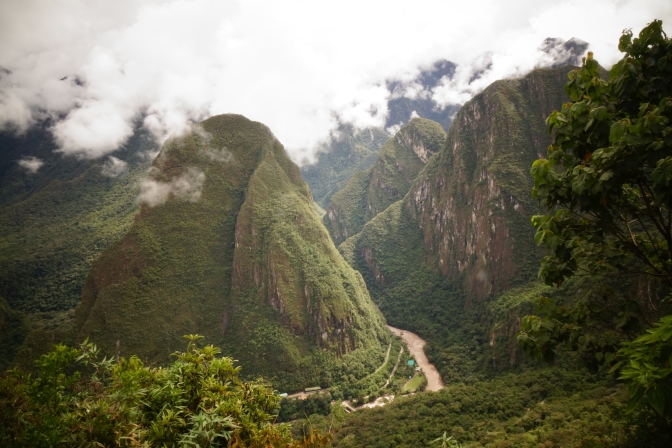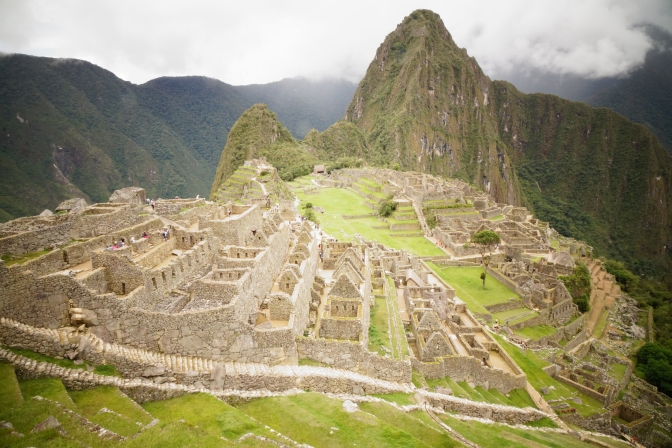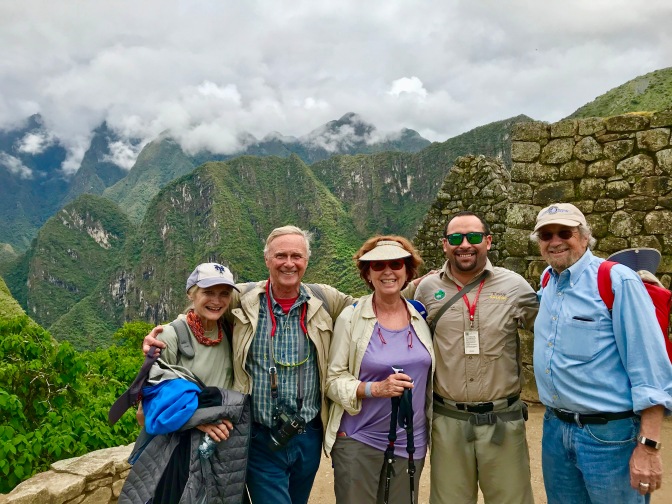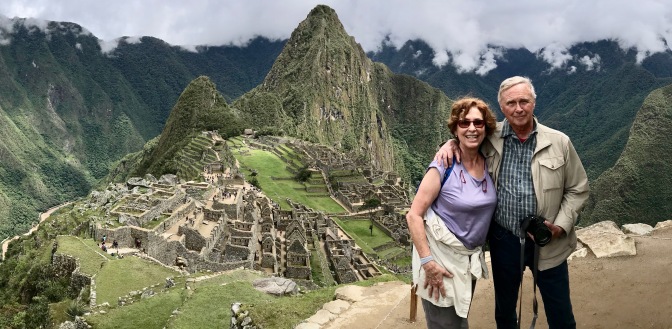
Until our recent trip, Louis was part of a large, sad cohort of tourists to Peru: People who get to Machu Picchu and never see the ruins because of the weather.
Just a week before our visit, our guide told us, there were five straight days when the clouds never lifted and the rain never stopped. He and tourists huddled at a viewpoint, sometimes for hours, waiting for a break long enough for visitors to snap at least one iconic shot. That would have been Louis when he was there on a story in the 2000s.
The picture at the top would be Louis in 2020. Although we made our pilgrimage in the country’s famously rainy season, a time when the hillsides have been known to slide across and block the site’s essential rail access, the only clouds we encountered were the ones photographers covet for their atmospheric shadows, and nary a raindrop fell. This produced some memorable photo opps for Louis and Partout.



Proof there is still life on the mountaintop
The 2.5-Hour Tour that Lasted 5.0
So smashing was the weather that our 2.5-hour guided tour lasted 5 hours. At one point, we all sprawled on the grass in the sunshine, Machu Picchu stretching just beyond our toes, Paul the guide regaling us with the site’s history, or at least his version of it.
He described the “neighborhoods” of the site and who lived where (e.g., priests, nobles, teachers, “chosen women”).

He explained things like how the Incas thatched their roofs, secured their doors, aligned their windows for solstices and canted their dry-stack walls 7%-13% to make them earthquake-proof.



He told us about the incalculable effort it took to deforest the mountaintop and lay structural foundations (20 years), to install underground drainage systems (180 of them) and terrace for walking and farming.

He assured us that, in addition to enjoying weather karma, we were enjoying crowd karma. On a typical day, now that the site is on everyone’s UNESCO bucket list, there are days when it’s hard to see the scenery for the selfie-takers. We had it almost to ourselves.

The Remaining Fog
Still, even on a clear day, it turned out, a lot of Machu Picchu’s history remains a bit foggy.

What were those women chosen for? And what about human sacrifice? Did they or didn’t they? Our licensed guide at Machu Picchu insisted tales of Inca sacrifice are just a case of bad publicity, but our licensed guide at Koricancha in Cusco – the most important temple of the Inca empire – said there are mummies with the wounds to confirm the Incas did sacrifice children.
Or what in the world motivated those imperialists to spend 50 years erecting walls and buildings with perfectly fitted stones the size of sofa sections? Our MP guide waxed on about the sacred nature of the site. “Why did they build on top of a mountain with no water and constant landslides? To be closer to God,” Paul told us. Meanwhile, back in Cusco, our temple guide said the mountaintop development was primarily a retreat for the nobility.
And then there is the Inca civilization itself. Raise your hand if you learned in school that South America was home to just three civilizations before the Spanish arrived: the Mayans in the Yucatan, the Aztecs in central Mexico and the Incas of Machu Picchu fame? That would be us.

Yet the Incas lasted in their glory barely a hundred years, the shortest-lived empire in world history, and they were highly derivative. Yes, they cobbled together the biggest dynasty on earth for its time (imagine Russia’s Bolsheviks ruling from St. Petersburg to Cairo to picture the scale), but they did not so much found a civilization as build one on their predecessors’ foundations, some quite advanced. The forerunning Tiwanaku, for example, had set up shop at one end of Lake Titicaca hundreds of years BC and, in their glory, built a capital city that featured a seven-layer pyramid and has been called one of the lost wonders of the ancient world.
Who cares? Sunny, rainy, foggy or clear, Machu Picchu is a marvel of a ruin, and we were all happy we arose at 4 am to take a 90-minute car shuttle, followed by a 90-minute train ride, succeeded by a 25-minute bus ride, and and then climbed the 162 floors (thank you, Fitbit) it took to get there.

Tips from the Partout toolbox: Some US websites will not allow access by visitors using browsers in foreign countries. Social Security, Medicare, the portal for Doris’s physician group, even a consumer survey have refused to allow us to connect at one time or another. Our solution is a free VPN (virtual private network) that fools these sites into thinking we are in the States. There are many out there, but Doris likes TunnelBear because it is so satisfying to watch the little bear tunnel out of her foreign location and pop up in the US. Downloading one of these before leaving on an international trip may be the difference between accessing needed information from the road and not.
COMING SOON! Sailing in Darwin’s Wake
Glad you made it to Machu Picchu and that the weather was so cooperative!
Wally
LikeLiked by 1 person
Our day could not have been more perfect.
LikeLike
Great pictures, you were so lucky!
LikeLiked by 1 person
You two sure had nomad karma for this part of your trip. The photos are spectacular! What a giddy experience! So glad the effort to get there worked out so perfectly.
LikeLiked by 1 person
You hit Machu Picchu so perfectly wonderful. Thanks for the story and the photographs. Wow is all I can say.
LikeLike
Really remarkable first person account of a place in itself is beyond remarkable!
LikeLiked by 1 person
Quite a hike, enjoy
LikeLiked by 1 person
Going our way, we are in Merida… for February… love to renew friendship.
Sent from my iPhone
>
LikeLike
Merida, Mexico? Or another one?
LikeLike